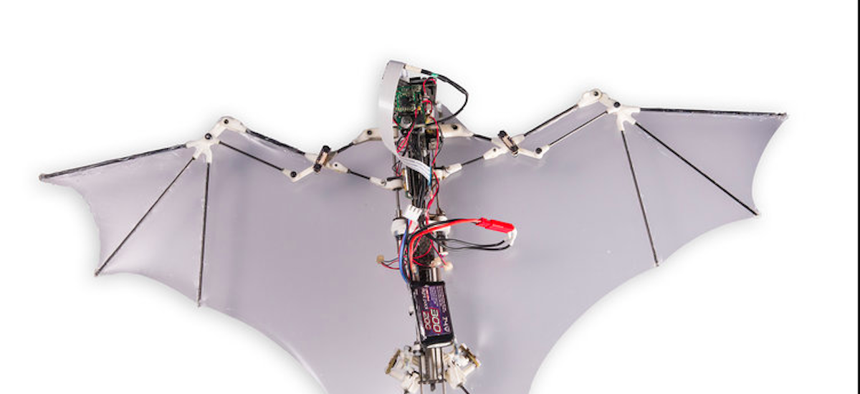
Soon-Jo Chung BATBOT 2 from Caltech’s Center for Autonomous Systems and Technologies. Caltech’s Center for Autonomous Systems and Technologies
Pentagon Seeks Laser-Powered Bat Drones. Really.
A new contest seeks flight systems inspired by Mother Nature and powered by directed-energy beams.
Tired: multi-rotor copters and fixed-wing drones. Wired: flying robots that move like living animals, are crafted of next-generation materials, and draw their power not from batteries but energy beamed from nearby aircraft.
On Wednesday, the the Defense Enterprise Science Initiative, or DESI, announced a competition for basic science grants to build “new paradigms for autonomous flight, with a focus on highly-maneuverable platforms and algorithms for flight control and decision making.” An accompanying Broad Agency Announcement gets more specific: basically, they’re looking for bat-like drones that can be powered with directed-energy beams.
“The biological study of agile organisms such as bats and flying insects has yielded new insights into complex flight kinematics of systems with a large number of degrees of freedom, and the use of multi-functional flight surface materials,” the announcement reads. The Air Force believes that more and more naturalistic design — coupled with more powerful and smaller sensors to form a better picture of the outside world — should yield “significant improvements in maneuverability, survivability and stealth over traditional quadcopter or fixed wing designs.”
Biomimetic, or nature-imitating, designs for crawling, slinking and even swimming robots go back decades. The late 1960s brought a biologically inspired robot called Orm . But the field accelerated in the late 1990s and early 2000s, bolstered by labs at MIT , Harvard , Stanford , and Berkeley and research out of Japan and China. (Chinese robotic fish are nearly ten years old .) The Defense Department eventually commissioned its first bio-inspired robot, a wall-climber called SpinyBot , which debuted in 2006.
But getting flying machines to mimic nature is a good deal more difficult and more complicated than teaching robots to swim and crawl, which is why even the military’s smallest drones have followed conventional aerodynamic designs.
One of the key barriers is power distribution. Running a motor to spin a propeller is a straightforward affair. While there are multiple examples of flexible-wing drones today, such as the bird-like RobotSwift and the bat-like RoboBat , today’s best consumer bird-like drones can generally fly for just a few minutes . That works for a lunch break in the park but not great for fighting deep behind enemy lines. But what if you could juice up your drone in flight by hitting it with a laser?
“Wireless power transmission could augment existing technologies and enable new paradigms for warfighter operations in denied environments, unmanned or autonomous surveillance and weapons systems,” the announcement reads.
From where would the power be beamed? The announcement leaves that up to the proposer, but suggests that it could be “transmitted either from the ground or from a high-altitude platform.” Read that to mean a plane overhead invisibly shooting power to the bird drone.
The other challenge: constructing a sensing, seeing, computing drone from something other than metal. The announcement also calls for new research into next-generation airplane skins that sense and even transmit data from the environment around them while also moving to allow high maneuverability. “To achieve robust, resilient, and energetically versatile agility and dexterity rivaling biological systems, robotic systems require breakthrough components featuring locally tunable material properties with embedded sensing and actuation.”
The total ceiling for the grants is $6 million.




